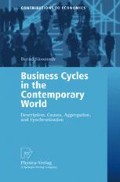Abstract
The American experience indicates that the major business cycle has had an average duration of a little over eight years … Since one to two minor peaks regularly occur between the major peaks, it is clear that the minor cycle is something less than half of the duration of the major cycle.
Access this chapter
Tax calculation will be finalised at checkout
Purchases are for personal use only
Preview
Unable to display preview. Download preview PDF.
Notes
This reverting to OECD and IMF data sources concerns in detail: the private consumption (CON) series for Canada for the years from 1961 to 1963 and the observation for 2000. The GDP series for Canada from 1961 to 1964, the total private investment (TPI) series for Canada for the years 1961 to 1963, 1993, 1994 and 1997 to 2000, as well as for the US from 1996 to 2000. The data for gross fixed capital formation (GFCF) and inventory investment (II) series stem for all analyzed economies from OECD databases.
The quantities are throughout billion US$ in prices and exchange rates from 1990.
In parentheses are the (eventually) more familiar notations, mainly, though not uniformly, used by the central databases of EUROSTAT, OECD and IMF.
Remember the MBK-filter shortens the series by three datapoints at the beginning and end of the series, respectively.
Even outnumbering the SSD measure of US GDP by taking on a value more than 5-to 6-times that of GDP.
The question of indications for ‘automatic stabilizers’ (i.e. stabilization through GOV) on the basis of these and the following findings is discussed in Süssmuth (2002c).
Note, there exist several tests that avail this feature of the integrated spectrum to test on cyclicality. These include the Fisher Test, Bartlett’sTest, the Durbin-Test and the Kolmogorov-Smirnov-Test, see for example Brockwell and Davis (1991,§10.2). Unfortunately, they are throughout of weak power and based on the (nonparametric) periodogram method and therefore unsuited for the short time series under analysis in the present study.
Aliasing in the context of spectra] analysis denotes the case when two frequencies close in value “fuse” due to their closeness to one single frequency in the spectrum; see, for example, Marple (1987, section 2.6).
Contributing roughly 30% to the standard deviation of the Japanese GDP cycle component.
Although there is another shorter period cycle of about 3 to 4 years length that less coherently fluctuates in line with the Japanese GDP cycle.
These, although sometimes showing two periodicities at their respective maximum of squared coherency, are dominated by a 5 to 5.5 years cycle that manifests itself and is reflected in the US GDP cycle — at least for the MBK-filtering routine.
I.e. the real parts of the cross-spectra, implied in squared absolute expressions in the nominator of the coherence spectrum’sdefinition, see equation (3.30) above.
In a similar vein, though quite more pessimistic, K. Hasset (American Enterprise Institute) states on the recent situation of the US economy in Wall Street Journal Europe (article: Rx for the Economy, May 7, 2001): “Christina and David Romer found that fiscal measures generally have failed to push the economy out of recession because they have been too small to have much of an effect. Indeed, large fiscal stimulus packages have generally not been passed near cyclical troughs. Instead, they have historically emerged only because of slow recoveries, as was the case with the 1964 tax cut.”
Cf. also the discussion in Muellbauer (1997), whether Great Britain really should participate in Delors II from a strategic (business cycle) policy point of view.
Regarding the national stylized facts above, the reader may be warned that the latter result may be dependent on the applied detrending procedure.
A recent related figure by Stephen Roach (Morgan Stanley) was cited in Wall Street Journal Europe (article: Global Economic Contagion Spreading Gloom, July 6-7, 2001): “In aggregate, the U.S., Japan, and Germany account for 34% of the world’sGDP (based on International Monetary Fund data).”
Author information
Authors and Affiliations
Rights and permissions
Copyright information
© 2003 Springer-Verlag Berlin Heidelberg
About this chapter
Cite this chapter
Süssmuth, B. (2003). The G7 and Euro15 Economies: 1960 — 2000. In: Business Cycles in the Contemporary World. Contributions to Economics. Physica, Heidelberg. https://doi.org/10.1007/978-3-7908-2718-7_4
Download citation
DOI: https://doi.org/10.1007/978-3-7908-2718-7_4
Publisher Name: Physica, Heidelberg
Print ISBN: 978-3-7908-1532-0
Online ISBN: 978-3-7908-2718-7
eBook Packages: Springer Book Archive

